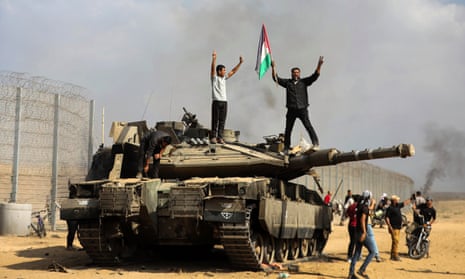Four of the world’s biggest news organisations have vigorously denied any prior knowledge of Hamas’s deadly assault on Israel on 7 October, saying such a suggestion was untrue, outrageous and reckless.
The suggestion appeared in an article by HonestReporting, which describes itself as an organisation devoted to fighting media disinformation about Israel and Zionism. It was taken up by two senior Israeli politicians, who said any journalists with prior knowledge of the assault should be treated as terrorists.
The Associated Press, Reuters, the New York Times and CNN issued robust statements in response to questions about Palestinian photographers in Gaza who documented Hamas’s cross-border raid in which at least 1,400 people were killed.
Gil Hoffman, HonestReporting’s executive director, has since admitted there was no evidence to back up the article’s suggestions, but said “they were legitimate questions to be asked”.
Benny Gantz, a former defence minister who sits in Israel’s war cabinet, said on X, formerly Twitter: “Journalists found to have known about the massacre, and [who] still chose to stand as idle bystanders while children were slaughtered, are no different than terrorists and should be treated as such.”
Danny Danon, a former Israeli ambassador to the UN, said Israel had a list of people it would “eliminate” for participating in the raid, and that journalists who recorded the assault would be “added to that list”. He added: “We will hunt them down together with the terrorists.”
The Israeli prime minister’s office said: “These journalists were accomplices in crimes against humanity; their actions were contrary to professional ethics.”
Some of the photographs sent out by the news agencies were published by the Guardian and other media outlets.
In a statement, the New York Times said the accusation that anyone at the news organisation had advance knowledge of the terrorist attack was “untrue and outrageous”.
It added: “It is reckless to make such allegations, putting our journalists on the ground in Israel and Gaza at risk. The Times has extensively covered the October 7 attacks and the war with fairness, impartiality, and an abiding understanding of the complexities of the conflict.”
Referring to Yousef Masoud, a photojournalist named by HonestReporting and who has worked with the New York Times over the past five weeks, the news organisation said: “There is no evidence for HonestReporting’s insinuations. Our review of [Masoud’s] work shows that he was doing what photojournalists always do during major news events, documenting the tragedy as it unfolded.”
It said freelance photojournalists in conflict areas often “rush into danger to provide first-hand witness accounts and to document important news. This is the essential role of a free press in wartime.”
The Associated Press said it had no knowledge of the 7 October attacks before they happened, and had received photographs from freelancers about an hour after the assault began.
“No AP staff were at the border at the time of the attacks, nor did any AP staffer cross the border at any time. When we accept freelance photos, we take great steps to verify the authenticity of the images and that they show what is purported,” it said.
Reuters said it “categorically denies that it had prior knowledge of the attack or that we embedded journalists with Hamas on October 7. Reuters acquired photographs from two Gaza-based freelance photographers who were at the border on the morning of October 7, with whom it did not have a prior relationship.
“The photographs published by Reuters were taken two hours after Hamas fired rockets across southern Israel and more than 45 minutes after Israel said gunmen had crossed the border. Reuters staff journalists were not on the ground at the locations referred to in the HonestReporting article.”
CNN said: “We had no prior knowledge of the October 7 attacks.”
The AP and CNN said on Thursday they had severed ties with Hassan Eslaiah, a freelance photographer who took images of Hamas gunmen crossing the border. HonestReporting posted a photo of Eslaiah being kissed by the Hamas leader, Yahya Sinwar.
The US Republican senator Tom Cotton called on the justice department to investigate the media outlets in question, claiming without evidence that the journalists “almost certainly knew about the attack in advance”. In 2020 Cotton caused outrage by calling for the military to be used against “Antifa terrorists” during nationwide US protests for racial justice.
In its article, HonestReporting said: “Hamas terrorists were not the only ones who documented the war crimes they had committed during their deadly rampage across southern Israel. Some of their atrocities were captured by Gaza-based photojournalists working for the Associated Press and Reuters news agencies, whose early morning presence at the breached border area raises serious ethical questions.”
It added: “Is it conceivable to assume that ‘journalists’ just happened to appear early in the morning at the border without prior coordination with the terrorists? Or were they part of the plan?”
At least 39 journalists and media workers have been killed in the Israel-Gaza war so far, according to the Committee to Protect Journalists, making it the deadliest month-long period since records began in 1992. A further eight have been wounded and 13 are missing.
Sherif Mansour, of the CPJ, said: “Journalists are civilians doing important work during times of crisis and must not be targeted by warring parties. Those in Gaza, in particular, have paid, and continue to pay, an unprecedented toll and face exponential threats.”
Associated Press and Reuters contributed to this report.
